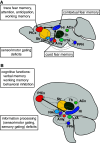Transcription factor 4 (TCF4) and schizophrenia: integrating the animal and the human perspective
- PMID: 24413739
- PMCID: PMC11113759
- DOI: 10.1007/s00018-013-1553-4
Transcription factor 4 (TCF4) and schizophrenia: integrating the animal and the human perspective
Abstract
Schizophrenia is a genetically complex disease considered to have a neurodevelopmental pathogenesis and defined by a broad spectrum of positive and negative symptoms as well as cognitive deficits. Recently, large genome-wide association studies have identified common alleles slightly increasing the risk for schizophrenia. Among the few schizophrenia-risk genes that have been consistently replicated is the basic Helix-Loop-Helix (bHLH) transcription factor 4 (TCF4). Haploinsufficiency of the TCF4 (formatting follows IUPAC nomenclature: TCF4 protein/protein function, Tcf4 rodent gene cDNA mRNA, TCF4 human gene cDNA mRNA) gene causes the Pitt-Hopkins syndrome-a neurodevelopmental disease characterized by severe mental retardation. Accordingly, Tcf4 null-mutant mice display developmental brain defects. TCF4-associated risk alleles are located in putative coding and non-coding regions of the gene. Hence, subtle changes at the level of gene expression might be relevant for the etiopathology of schizophrenia. Behavioural phenotypes obtained with a mouse model of slightly increased gene dosage and electrophysiological investigations with human risk-allele carriers revealed an overlapping spectrum of schizophrenia-relevant endophenotypes. Most prominently, early information processing and higher cognitive functions appear to be associated with TCF4 risk genotypes. Moreover, a recent human study unravelled gene × environment interactions between TCF4 risk alleles and smoking behaviour that were specifically associated with disrupted early information processing. Taken together, TCF4 is considered as an integrator ('hub') of several bHLH networks controlling critical steps of various developmental, and, possibly, plasticity-related transcriptional programs in the CNS and changes of TCF4 expression also appear to affect brain networks important for information processing. Consequently, these findings support the neurodevelopmental hypothesis of schizophrenia and provide a basis for identifying the underlying molecular mechanisms.
Figures



References
-
- Murre C, Bain G, van Dijk MA, et al. Structure and function of helix-loop-helix proteins. Biochim Biophys Acta. 1994;1218:129–135. - PubMed
-
- Ferré-D’Amaré AR, Prendergast GC, Ziff EB, Burley SK. Recognition by Max of its cognate DNA through a dimeric b/HLH/Z domain. Nature. 1993;363:38–45. - PubMed
-
- Bertrand N, Castro DS, Guillemot F. Proneural genes and the specification of neural cell types. Nat Rev Neurosci. 2002;3:517–530. - PubMed
Publication types
MeSH terms
Substances
LinkOut - more resources
Full Text Sources
Other Literature Sources
Medical

